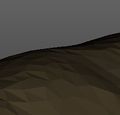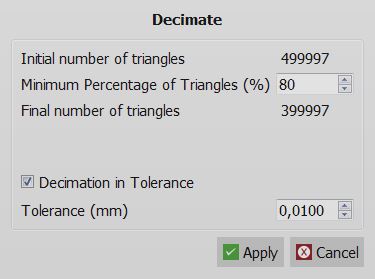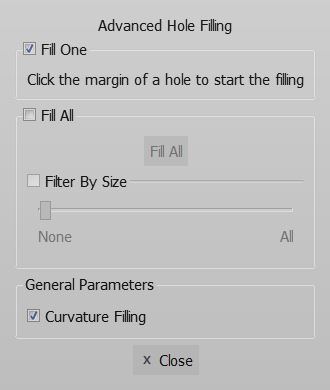Modificare le Mesh
Contents
Modificare le Mesh
Una volta convertiti i dati in formato mesh, potrebbero essere necessarie alcune modifiche per renderle più idonee all'uso designato.
Le mesh potrebbero infatti avere difetti, rumori o buchi che devono essere compensati.
OpticalRevEng Dental applica automaticamente delle strategie di generazione delle Mesh specifiche a ogni elemento. Potrebbe però essere necessario modificare ulteriormente i dati prima di esportarle in un altro software.
Qui di seguito vengono descritti gli strumenti di Modifica delle Mesh, disponibili sia nel Menù Mesh o nella Barra degli Strumenti delle Mesh.
Rimuovi Picchi
Un picco in una mesh è per definizione una parte minuscola di superficie che non fa realmente parte dell'oggetto 3D scansionato.
In generale, i picchi vengono corretti automaticamente nel processo di generazione delle mesh ma, se le mesh vengono importate da un altro sistema, potrebbero essere presenti.
Questo strumento rimuove automaticamente i picchi e ripara la mesh.
Affilatura Mesh
Lo strumento di affilatura liscia le parti planari della superficie e, allo stesso tempo, affila i bordi della mesh. Per eseguire questa operazione sono disponibili due parametri:
- T [°] :questo angolo definisce cosa sia un bordo. Tutte le parti della superficie il cui angolo è minore a T° saranno affilate. Quando il valore è a 0, tutta la superficie verrà lisciata
- Ripetizioni: il numero di volte che il software passerà sulla superficie per affilarla. Più il valore è alto, più la superficie verrà lisciata e affilata.
Il software applica in automatico questo strumento, utilizzando parametri specifici. Applicare lo strumento con parametri non ottimali potrebbe modificare la forma e la dimesione dell'oggetto.
Liscia Mesh
Simile all'Affilatura, questo strumento liscia la superficie dell'ogetto senza però preservanrne i bordi.
Il software applica in automatico questo strumento, utilizzando parametri specifici. Applicare lo strumento con parametri non ottimali potrebbe modificare la forma e la dimesione dell'oggetto.
Decima Mesh
Questo strumento riduce il numero di triangoli in una mesh, per ottenere file più piccoli, cercando di mantenere la maggior quantità di dettaglio possibile.
Il primo valore specifica il numero di triangoli di partenza delle mesh selezionate.
È possibile specificare che percentuale di trangoli va preservata (Per esempio stabilendo un valore del 50% dimezza la quantità di triangoli).
È inoltre possibile stabilire un valore di tolleranza. Se il valore di tolleranza è attivo, il software fermerà la decimazione prima che la mesh venga modificata più del valore settato.
Just click on Apply to see the result.
Mesh Defeature
This tool takes a selection of the mesh and it removes all the details, leaving the surface as plane as possible. It removes holes, spikes, noises. To use this tool:
- Select the area in which it is necessary to remove all the features with the Selection Tools
- Apply the Mesh Defeature
Make Manifold
This tool searches and removes the parts of the surface that are not Manifold. Look at: definition
Mesh Catenate
This tool can be used only in Free Mode. It takes all the selected meshes and creates a single mesh, merging all of the selected meshes together.
Flip Normals
Every mesh has an inside and an outside. The software gives them two different colors. This tool inverts the inside and the outside of the selected meshes.
Detect Intersections
Sometimes, it is possible that part of the surface of a mesh is intersected with the mesh itself, something that in reality is not possibile. This tool identifies this situation and fixes it.
Fill All Holes
This is an interactive tool that allows to fill the holes in the currently selected mesh.
This tool can work in 2 different ways
Fill One
In the fill one mode, the software will highlight the hole near the mouse cursor. By clicking with the left mouse button on the highlighted hole it will be filed.
Fill All
In the fill all mode, the software will try to close all the holes. With the Filter By Size function, it is possible to select all the holes below one size and fill them. The selected holes will be highlighted in real time by the sofware.
Curvature Filling
There is an additional option: curvature filling. If this option is enabled, the software will try to close the hole following the curvature of the rest of the surface. If it's disabled, the software will ignore the rest of the surface and close the hole with a straight plane.
Close Denture
When scanning a whole jaw, the base information will not be acquired. This tool has been created to recreate that information. Closing the dunture with the Fill All Holes tool takes too much time and the final result will not be good enough.
With the close denture tool, the mesh will be closed with a perfect plane in a reduced amount of time.
This tool will not work if the mesh has other holes or defects.
Mesh Cleaning
This removes all the possible defects and noises of a mesh.
Mesh Offset
This tool creates a bigger/smaller version of the selected mesh. The Offset [mm] parameter allows to select how much the mesh will change.
The three flags (Remesh, Sharpen and Optimize Vertices) have to be checked.
Usually, none of these tools is necessary to work because the strategies already apply a selected sequence of specific tools to each element.






